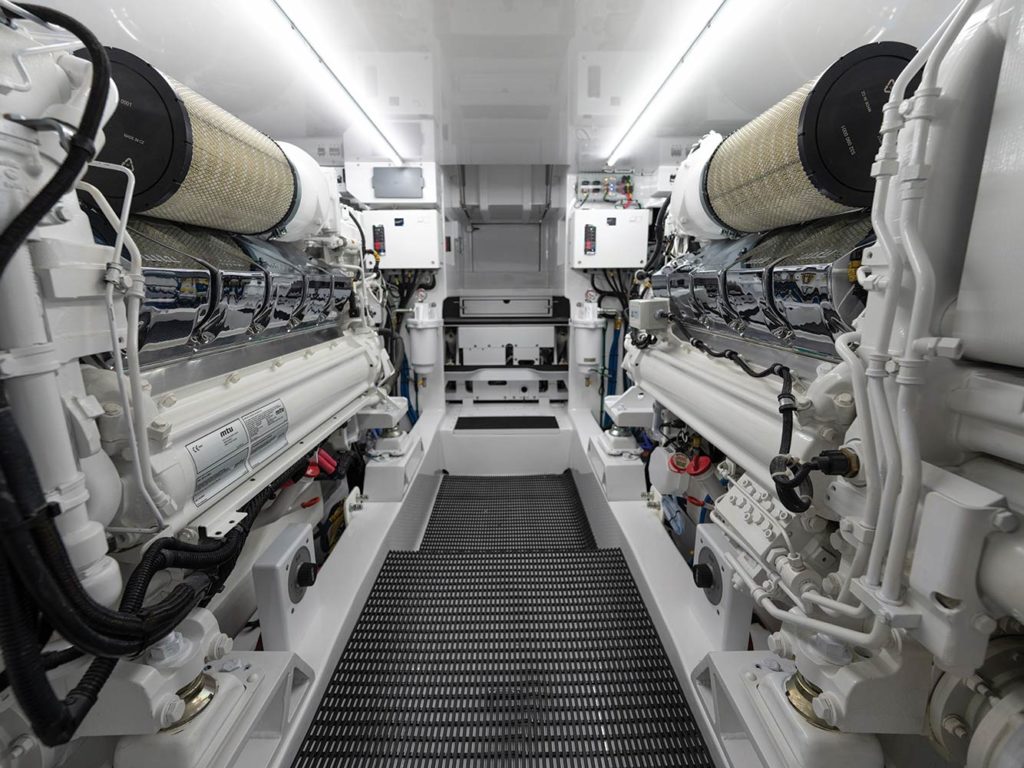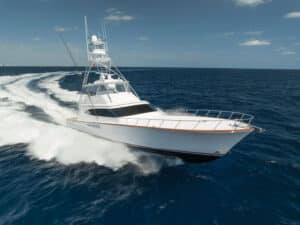
Special delivery: Sign up for the free Marlin email newsletter. Subscribe to Marlin magazine and get a year of highly collectible, keepsake editions – plus access to the digital edition and archives.
With more than 60 builds under its belt, Jarrett Bay is used to turning clients’ dreams into hardcore fishing machines. So, naturally, when this project came up in discussions, the builders were eager to sink their teeth into the project and crank out the Swiss Army knife of sport-fishing boats. Renegade was built for a gentleman whose experience concentrates around South Florida sailfishing from larger center-consoles, but he wanted a boat that would travel well and provide all the family vibes he was looking for. At 56 feet, Hull No. 67 really is the perfect size to do a lot of, well, everything.
What appears to be an ordinary open-flybridge sportboat quickly turns extraordinary as you get closer, realizing that the forward mask is not really a mask at all, but rather a windscreen for the lower helm station. I had the pleasure of hopping on Renegade with Capt. Brian Tambone in Fort Lauderdale, Florida, the day before the city’s international boat show. It didn’t take but a few seconds for me to marvel at all of the build’s custom touches, and I hadn’t gone any farther than the cockpit.

Cockpit and Engine Room
As I looked around, I could see that this was a sailfishing dream. A massive center transom livewell with a window holds up to 100 gallons, and when you want to keep your baits separated by species, Renegade is already plumbed for removable livewells, with the outflows tucked nicely in the scupper drains via a custom drain plate.
On the days when the kites don’t want to stay up, the starboard tackle center is permanently plumbed for helium delivery—fed by a large, removable tank that is custom-mounted, out of the way in the engine room—so gone are the days of steel tanks wrapped in towels lying on the salon floor. Next to the helium discharge, a built-in pump allows inflatable fenders flattened for traveling to be filled at a moment’s notice; gaff and brush storage and a Kenyon grill round out this fully functional tackle center.
Centered in the deck is a cavernous fish box, with a built-in ice dump and plenty of room to keep your catch cold, even on the days you limit out. And if that 120-gallon fish box doesn’t hold enough, there is an additional 50 gallons of available ice under the starboard step—perfect for icing drinks or cooling those fish that require pulling out the fish bag. If you do the math, both boxes provide roughly 1,200 pounds of ice capacity. A 40-gallon drink box and a 40-gallon freezer are under the mezzanine step, and on days when you need tuna tubes, they can be found hidden in the transom under the covering boards. Just pop the lid with a custom-made magnetic tool, or hide them completely when not in use.
Next stop: the engine room. As I stepped down, I noticed how bright it was, and at 6-plus-feet tall, I had plenty of headroom to move around—even outboard of the engines—without breaking a sweat, as a generous AC pumped in cool air throughout the entire space. MTU 10V2000 M96s are the heartbeat in this 56-footer, sporting 1,600 mhp per side, packing plenty of punch in a reasonably compact package.
Forward you’ll find an FCI watermaker, AXI fuel-polishing system, Dometic chillers, Electrosea Clearline system, and a 25 kW Northern Lights generator. Mounted above the genset, the master breaker panel was completely backlit and well-organized. The Seakeeper 18 (yes, you read that correctly) is tucked neatly under the removable steps; it has enough stabilizing power to hold boats in the 65- to 75-foot range steady, even when it’s blowing well over 20 knots out of the north on the South Florida fishing grounds.

Express and Bridge Decks, Accommodations
Walking through the polycarbonate enclosure onto the express deck laid with teak, a large helm resides in front of two Release helm chairs. Three massive Garmin 22-inch multifunction displays provide navigation information, and a large, single-piece windshield allows for nearly 360-degree visibility from the centerline captain’s chair. The steering wheel sits on a beautiful teak helm pod, which is outfitted with single-lever controls and a joystick. Forward of the helm is a large dinette. The table easily lowers flush with the seat and could be used as additional sleeping accommodations, if needed. Beneath the seats is rod storage for up to 10 8-foot spinning rods. On the starboard side is a generous wet bar with Sub-Zero refrigerators below. A 50-inch flat-screen TV rises from the forward corner when it’s game time or movie night.

The flybridge sports a peninsula-style console that is almost identical to the helm station below. Engine displays are molded in the hardtop, with teaser reels situated in a box directly above the captain. There is ample seating for the whole crew with a starboard-side bench and an L-shaped bench in front of the console. Both seating arrangements feature additional storage. The bridge sole is covered in custom faux-teak decking with laser-engraved inlays for a safe and soft-under-foot feel. This 56-footer is also equipped with a full tower featuring a 6-foot gap, standing platform and pod.
Renegade presents with a two-stateroom, one-head layout. A double bunkroom sits to starboard; the master is forward and the head to port. Jarrett Bay’s own beautiful walnut and maple flooring is found below, with high-gloss walnut cabinetry throughout, and Terra Wave veneers accent the trim. A fully equipped galley includes a residential-size Sub-Zero refrigerator, Wolf induction cooktop, Bosch microwave, custom-mounted coffee maker, and drawers with custom inserts to hold your tableware and cutlery tight. A full tackle center neatly houses all of the owner’s fishing gear—custom-colored in Florida State University’s garnet and gold—and terminal tackle, which is neatly organized in storage boxes and drawers that can easily be pulled out to the cockpit when needed.

Performance
With Tambone at the helm, we maneuvered out of Port Everglades’ boat-show traffic in full swing as early sea trials took place around us. The traffic made the inlet a bit confused with wakes of various sizes, but Renegade ate it up, as expected. Even with the front enclosure open, we didn’t even get as much as a misting. We rounded the sea buoy heading south and spooled up the MTUs.
Thirty knots and a 75 percent load at 1,900 rpm burned 98 gph. As we approached the Dania Beach Pier, the throttles were pushed up to 2,000 rpm for an 80 percent load, burning 110 gph for a speed of 32 knots. We pulled back to check the drift, and I noticed that even without the Seakeeper engaged, Renegade was extremely stable, but with it on, she was rock-solid. We aggressively backed up and spun around in different directions—where the MTUs proved to have plenty of reserve power for those quick sailfish-tournament releases—problem-free.
Heading home, Tambone opened her up. At 2,450 rpm, Hull No. 67 burned 176 gph for a speed upwards of 39 knots against an outgoing tide. And as we idled up the Intracoastal Waterway, I must say, I enjoyed all of the other boats coming a bit closer to get a good look at those distinguishable Jarrett Bay lines. For a renegade, she sure lives up to the definition and absolutely defies the traditional behavior found in most hardtop express—or even perhaps conventional open-flybridge—models.

Jarrett Bay Boatworks 56 Specs
- LOA: 56’6”
- Beam: 17’6”
- Draft: 4’6”
- Displ: 70,000 lb.
- Fuel: 1,200 gal.
- Water: 250 gal.
- Power: MTU 10V2000 M96
- Gear/Ratio: ZF 2050A/2.029:1
- Propellers: Veem Sportfish 5-blade
- Paint: Alexseal, Cloud White
- Climate Control: Dometic
More Photos










